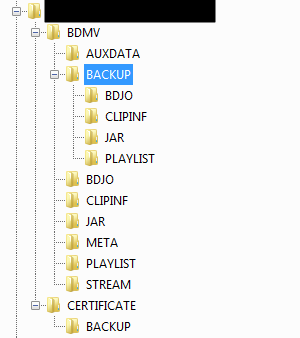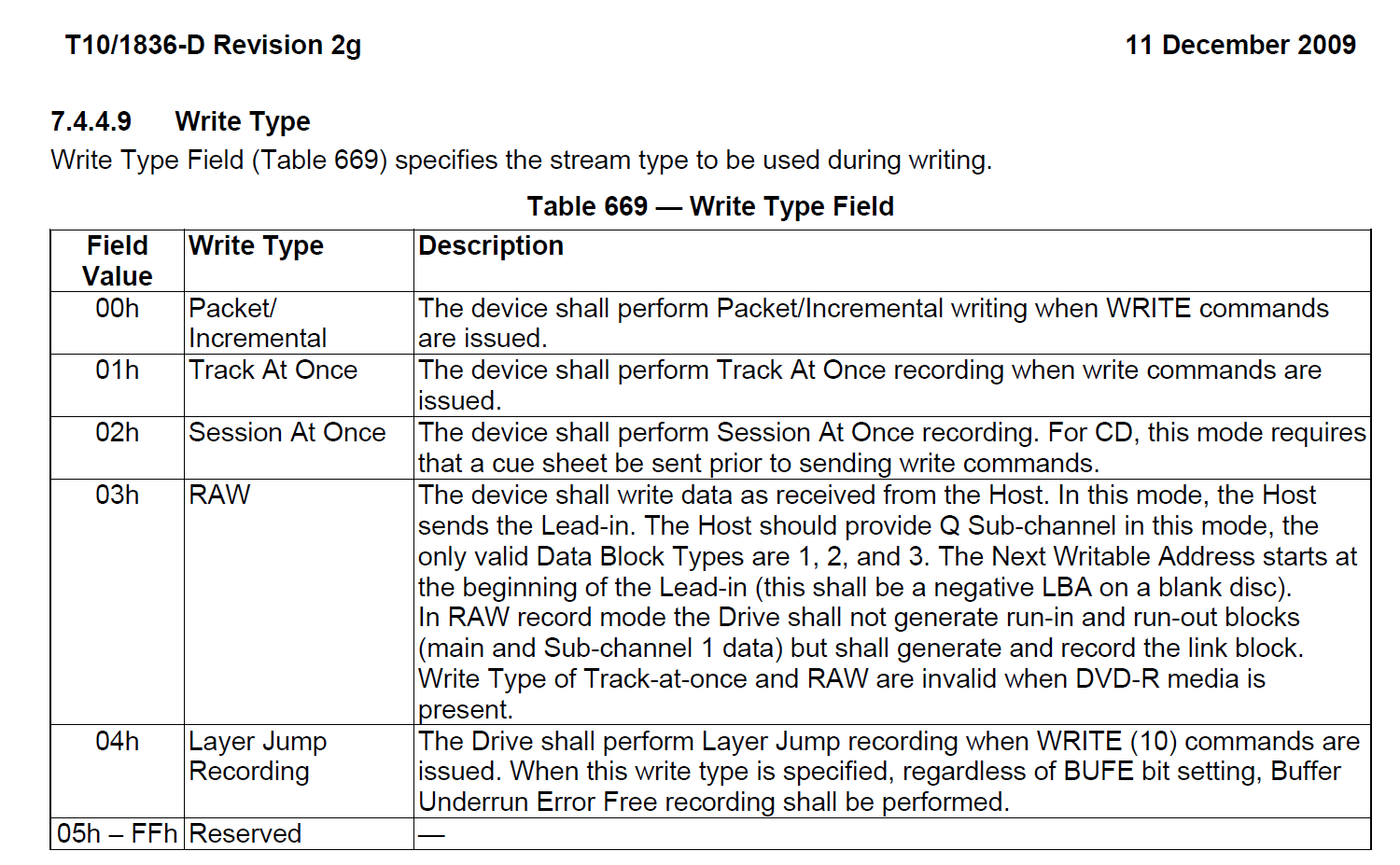All Activity
- Past hour
-
You only need 2 folders for a fully functioning Blu-Ray Video disc: BDMV and CERTIFICATE. And it may even be possible to get by without a CERTIFICATE, but I'm not sure. My Robocop Unrated Director's Cut Blu-Ray only has those 2 folders.
-
Sometimes tsmuxer doesn't create all the folders needed for Blu ray video format and this may lead to problems. Sometimes you have to create the missing folders manually (and leave them empty) This is the folder structure you need in order to have a fully functional BD-video disc: Also check if there is a .clpi file in CLIPINF folder, I believe it's needed for chapters to work.
- Yesterday
-
Yeah, I'll double-check to make sure the chapters are included. I'm just perplexed, because this hasn't been an issue before...
-
Well, those 2 folders are probably CERTIFICATE and BDMV. Regardless of which folder you added, that should not make a different as to why the resulting file wouldn't have chapters. I don't know much about M2TS. I would just make sure the input MP4/2 had chapter breaks to begin with. If they didn't, then I'd make sure TSMuxer had them listed in it. If all that was okay, then TSMuxer is apparently not adding in the chapters. Or whatever you're playing it back with, if it's PC software, isn't recognizing the chapter breaks. I'm more familiar with DVD and I know on DVD Video, there are VOB files, which are the video and audio containers, but they're raw files. Chapters are only added when you play the corresponding .IFO files related to the VOB's. So, maybe there's a similar structure with M2TS. Playing an M2TS file natively may not have chapters associated with it.
-
Sorry. Yeah, it's a Blu-ray video BD-R. It was created with tsmuxer. The original file is an mp4 (or mp2...I'll have to check), but once muxed, it's a m2ts, and I've included chapters in that muxing. It's the same way I've always created them; the only difference is that I'm trying to burn two folders onto the disc instead of the usual one, so I didn't know if that had something to do with it. I know that doesn't sound technical, but that's about my extent 🤣
-
dbminter started following Chapters
-
Well, this isn't much to go on. You haven't said what created your BD. Is this a Blu-Ray Video BD? If so, something created the BDMV, which may not have made it correctly. Are you playing MP4 or some other video container file type burned to BD-R in your player? If so, does the container file itself actually have chapter marks in it?
-
frodawgg started following Chapters
-
Howdy! If this is the wrong section of the forum, I apologize--just let me know. I've been using imgburn for years for my BDs and have never had this problem. I burned two movie titles (folders) to a BD for the first time (I had only done single-title discs before this), and the chapters are not working for either movie. I'm sure the chapters are part of the files because I had previously burned one by itself and was able to use them. Does anyone know why this may be? Thanks!
- Last week
-
frodawgg joined the community
-
David Dixon joined the community
- Earlier
-
Is the media creation date stored in the "Volume Set Identifier"? I want to know the burn dates of my mastered BD-R media
AlbertEinstein replied to AlbertEinstein's topic in ImgBurn Support
Still, GUIDs on Windows systems always include the date/time because it's one of the things that changes constantly and, therefore, imparts uniqueness when things need to be this way. A volume set identifier would need to be unique as well so there's a good chance the developer uses a date/time as "part of" the volume set identifier. -

Is the media creation date stored in the "Volume Set Identifier"? I want to know the burn dates of my mastered BD-R media
dbminter replied to AlbertEinstein's topic in ImgBurn Support
Yeah, the Volume Label. I couldn't think of its name at the time. -
Is the media creation date stored in the "Volume Set Identifier"? I want to know the burn dates of my mastered BD-R media
AlbertEinstein replied to AlbertEinstein's topic in ImgBurn Support
Yes, in the volume label, unless you were referring to something else. Just depends on how many similar or different things I'm burning onto a specific BD-R disc I guess. -

Is the media creation date stored in the "Volume Set Identifier"? I want to know the burn dates of my mastered BD-R media
dbminter replied to AlbertEinstein's topic in ImgBurn Support
And you could, if you've got spare Label characters, put the date in there. -
Is the media creation date stored in the "Volume Set Identifier"? I want to know the burn dates of my mastered BD-R media
AlbertEinstein replied to AlbertEinstein's topic in ImgBurn Support
Yes, something along those lines will work, if, he doesn't use a date/time stamp in that Volume Set Identifier. I just had another idea also. There are 5 fields you can populate with data on the "Labels" tab called "Volume Identifiers". One of them is called "System" so I could just generate a date/time and cut'n'paste into that field. But, reading those fields would only be easy using ImgBurn, I imagine. So.....maybe a text file with the most recent date/time in the root of the DISC as you suggested. Even in the volume label itself if you don't need the full 128 ASCII characters that a UDF label provides. Just kicking around some ideas. Or I could just go old skhool and pickup a sharpie after the burn and....you get the idea! I've actually done this before on a few platters. -

Is the media creation date stored in the "Volume Set Identifier"? I want to know the burn dates of my mastered BD-R media
dbminter replied to AlbertEinstein's topic in ImgBurn Support
I don't know this for sure, but I don't think there's any metadata burned to a disc by ImgBurn that tells when it was written. The closest you can probably get is to check the date/time stamps on files on the media and you might get an idea. One thing I do when Building an ISO is put a folder in the root directory with the current date to let me know when it was created. -
Is the media creation date stored in the "Volume Set Identifier"? I want to know the burn dates of my mastered BD-R media
AlbertEinstein posted a topic in ImgBurn Support
I'd like to know if the media creation date is stored in the "Volume Set Identifier" by chance and if so, is it a date and time, just a date, and how many characters do I need to convert it to an actual operating system date and time? I know the log file stores enough data to possibly get it from there but let's pretend that got deleted by accident or corrupted. And I wanna get it from the media itself. Is this possible? -
Matt McGlone joined the community
-
Yes, everything is fine and as it should be.
-
hi sorry english is not my native language so , the log is perfect , i dragged a cue and started to burn and in the log there is SAO so it's perfect for audio cd sao , isn' it? just i remember some software have an option to select dao , sao or tao thanks
-
Like I said, it's the same thing. That's why the option says DAO/SAO and they aren't 2 different options. No extra session gets opened and you've burnt the disc in one go without any forced gaps. That's DAO. The MMC specs just referred to it as SAO for CD and so that's why the program calls it what it does.
-
hi i have burned a cue +wavfile and in the log there is write type sao how can i push imgburn to use dao? thanks
-
Unless you’re creating a CD-Extra disc, there won’t be any additions sessions and so you’ve essentially just burnt in DAO mode. So that would be the standard method of burning an audio cd in ImgBurn anyway. If you want control over the gaps between tracks, you just need to avoid TAO.
-
rosanna started following Help with Write Modes
-
Hi but when i burn an audio cd , imgburn does it perform always a sao burning i have always read disc at once should be the best for audio cd is there a way to push imgburn to use dao (disk at once) ? thanks
-
hanys1012 joined the community
-
Дентиси joined the community
-

Do yall know of any burners that are able to burn triple/double layer blu rays correctly?
dbminter replied to ultramegaburningenthiseist's topic in Chat
I think where I live, the US, it's a year. -
Do yall know of any burners that are able to burn triple/double layer blu rays correctly?
blask replied to ultramegaburningenthiseist's topic in Chat
24 months on most electronics, at least in my part of Europe. -

Do yall know of any burners that are able to burn triple/double layer blu rays correctly?
dbminter replied to ultramegaburningenthiseist's topic in Chat
I'm pretty sure you only get a 12 month guarantee on most electronics. -
Do yall know of any burners that are able to burn triple/double layer blu rays correctly?
blask replied to ultramegaburningenthiseist's topic in Chat
I hope it was still in guarantee. -

Do yall know of any burners that are able to burn triple/double layer blu rays correctly?
dbminter replied to ultramegaburningenthiseist's topic in Chat
Of course, right after I praised the ASUS for going strong for 1.5 years, I had to replace it Sunday night. So, it lasts for about 18 months with rigorous near daily use before it needed replacing. It developed an issue with its red laser.




